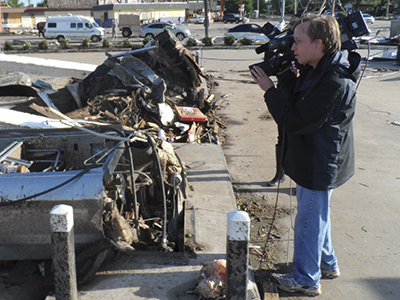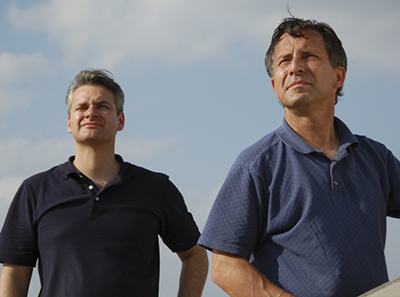When Weather Turns Deadly
OKLAHOMA CITY—On May 31, 2013, Weather Channel meteorologist Mike Bettes and two teammates miraculously survived after their “Tornado Hunt 2013” vehicle was thrown 200 yards in an EF5 tornado in El Reno, Okla. The Weather Channel crew was lucky: The same tornado killed professional weather researchers Tim Samaras, his son Paul Samaras, and Carl Young. Samaras’ in-close tornado footage had been extensively used on the Discovery Channel series “Storm Chasers.”
These incidents underlined the very real dangers associated with tornado-chasing, and the risks media crews run into when they deliberately head into danger to get exceptional footage. Given the news-viewing public’s appetite for such video, news directors are understandably eager to deliver great extreme weather coverage wherever possible. But the responsible ones, like Managing Editor Nathan Elliott of KWTV, News 9, the CBS affiliate in Oklahoma City, balance this hunger with employee safety.
“We’ve covered so many tornadoes, that we have refined an approach that is both effective in keeping our viewers informed— because that’s our primary mission—while protecting our newspeople and on-air staff,” Elliott said. “The goal is to cover the tornado as completely as possible, without trading off the safety of our people.”
A CONSIDERED APPROACH
Preplanning is the key to safe tornado coverage, according to Derrick Hinds, communications, marketing and digital media manager with the Radio Television Digital News Association. “Before disaster hits is the time to work out your procedures, including safe deployment and staff sheltering,” he said. “You don’t want to be improvising when extreme weather hits.”

KWTV Photographer Scott Cassidy films part of the destruction from the May 20th Moore, Okla. tornado as part of Oklahoma’s Own News 9’s coverage. One unnecessary risk is to send untrained ENG crews into danger by chasing tornadoes, said Steve Miller. He is a consultant with Weather Decision Technologies, a provider of web-based and mobile interactive weather mapping solutions for broadcasters and webcasters.
“Anyone with a camera and a vehicle can be a storm chaser, there are no regulations and no real rules,” Miller said. “I’ve seen many instances where a local affiliate or national network, even newspaper reporters, have traveled well outside their market in order to put together a piece on storm chasing or tornadoes. In a nutshell, uneducated participants in an uncontrolled situation spells trouble.”
When the meteorologists at News 9 forecast tornados—“thanks to modern technology, they can alert us days in advance,” Elliott said—the station alerts all of its staff, including experienced storm trackers, News 9 helicopter pilot Jim Gardner, and the entire news team. Then, when a tornado is detected as it was on May 31, the station follows a pre-set plan to cover the storm while minimizing employee risk.
The professional video industry's #1 source for news, trends and product and tech information. Sign up below.
“We begin by sending out our storm trackers,” said Nathan Elliott. “These are either trained staff members like our meteorologist David Payne, or freelancers who know the risks. They travel in vehicles equipped with HD video cameras and mobile streaming equipment, to get pictures back to us as soon as they can.”
News 9 also sends its helicopter aloft with pilot Gardner and a videographer. Thanks to its height and speed, the helicopter can stay safely away from an approaching tornado while sending back critically-important video in real time.
“While the tornado is on its way and then passing by, we keep our news people safely at our studio, which has tornado shelters,” Elliott said. “Only after it is past do we send them out in microwave trucks and rugged vehicles equipped with Teradek Cube and LiveU video streaming transmitters, to get the story back to our viewers fast.”
PROTECTIVE MEASURES
Mark Bell is a 45-year broadcast TV veteran, owner of the news safety consulting firm ENGSafety.com, and publisher of the ENG Safety Newsletter. He recommends equipping ENG crews with proper protective gear in extreme weather situations, such as hard hats, body armor, and steel-toed boots. At the same time, these crews need to be properly trained in assessing risks, and when not to take them.

Carl Young (L) and Tim Samaras of Discovery Channel’s “Storm Chasers” were killed when covering the Moore, Okla. tornado on May 31. “Perceptive field people understand the risks of exposure as well as the fact that there are not elaborate disability payments or pensions if they are injured for life, and step back a bit,” said Bell. “It’s up to veteran employees to educate newer employees about dangers, risks, and staying as clear as possible, or simply leaving the area of danger. It’s also up to station management to manage the risk employees are taking.”
WDT’s Steve Miller advises news crews covering tornadoes to take experienced storm-chasers along to provide expert advice, and to pack their vehicles carefully to minimize flying debris if an accident occurs. He also recommends giving these crews on-road access to weather-tracking applications, such as WDT’s iMap Weather Radio for weather alerts, and RadarScope for access to high-resolution radar imagery. “Always have information at your fingertips,” Miller said.
SAFETY FIRST
No matter how compelling the imagery, or how strong the drive to get the story first, News 9 never loses sight of its staff’s well-being. “When we cover extreme weather like the May 31 tornado, our primary mission is to keep people safe,” Elliott said. “This includes the people who work for us gathering this information, and the people who watch our wall-to-wall broadcasts.”
It all comes down to keeping priorities straight, according to Bell. Quoting renowned cameraman Stewart Pittman, who writes the Lenslinger.com blog, Bell said, “The next time you’re incredibly close to something sketchy, enjoy the view. But if that little voice in the back of your head begins screaming, do heed its plea... Sure, people might marvel over what you captured there at the end of your life. Hell, they’ll remember that shot forever. But make no mistake... They’ll forget YOU.”
James Careless is an award-winning journalist who has written for TV Technology since the 1990s. He has covered HDTV from the days of the six competing HDTV formats that led to the 1993 Grand Alliance, and onwards through ATSC 3.0 and OTT. He also writes for Radio World, along with other publications in aerospace, defense, public safety, streaming media, plus the amusement park industry for something different.

